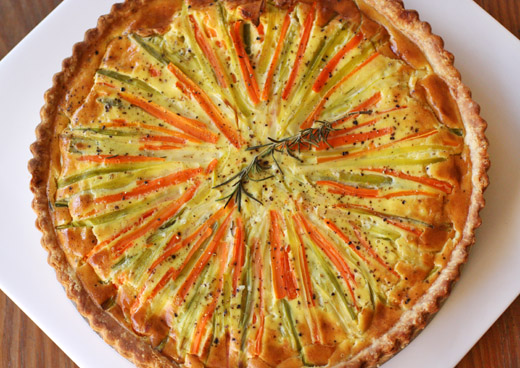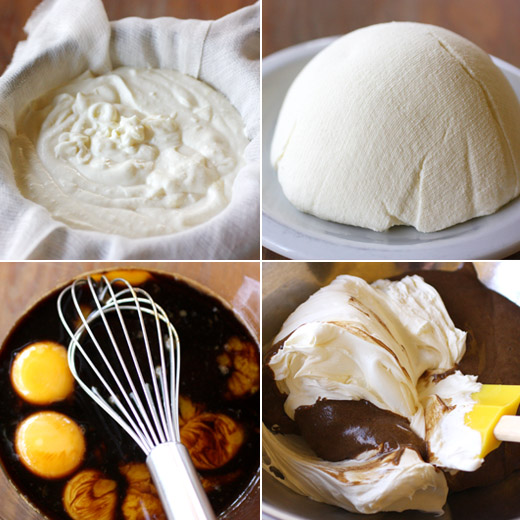Recipes from Alice Medrich are always precise and work like a charm, and now she's given us some really easy ones too. Her latest book is Sinfully Easy Delicious Desserts , and I received a review copy. It's a guide to building great desserts from a well-stocked pantry. There are recipes for baked desserts, custards, and sauces, but there are also numerous tips for combining different kinds of fruit or store-bought ingredients like ice cream with other components or sauces. And, most recipes come with suggested variations. This book teaches you to be a dessert-MacGyver. The list of "Things to do with vanilla ice cream" alone could fill all of your dessert menus for the rest of the summer. Some of those suggestions include: serving ice cream on cinnamon toast with chocolate or caramel sauce, and Medrich provides three different chocolate sauce recipes and four caramel sauces from which to choose; drizzling the ice cream with extra virgin olive oil, sprinkling with flaky sea salt, and adding dessert croutons; and topping ice cream with Bourbon-Brown Sugar Pecans and peach slices. In the Starting with Fruit chapter, there's a Saucy Cranberry Maple Pudding Cake that I can't wait to try this fall, a Blueberry Cornmeal Cobbler that I'll try very soon, and a list of various fruit sauces both chunky and smooth to add to other desserts. The ideas continue with cakes, cookies, and other sweet bites, and they're all completely simple to do.
, and I received a review copy. It's a guide to building great desserts from a well-stocked pantry. There are recipes for baked desserts, custards, and sauces, but there are also numerous tips for combining different kinds of fruit or store-bought ingredients like ice cream with other components or sauces. And, most recipes come with suggested variations. This book teaches you to be a dessert-MacGyver. The list of "Things to do with vanilla ice cream" alone could fill all of your dessert menus for the rest of the summer. Some of those suggestions include: serving ice cream on cinnamon toast with chocolate or caramel sauce, and Medrich provides three different chocolate sauce recipes and four caramel sauces from which to choose; drizzling the ice cream with extra virgin olive oil, sprinkling with flaky sea salt, and adding dessert croutons; and topping ice cream with Bourbon-Brown Sugar Pecans and peach slices. In the Starting with Fruit chapter, there's a Saucy Cranberry Maple Pudding Cake that I can't wait to try this fall, a Blueberry Cornmeal Cobbler that I'll try very soon, and a list of various fruit sauces both chunky and smooth to add to other desserts. The ideas continue with cakes, cookies, and other sweet bites, and they're all completely simple to do.
As I read about the flans in the book, I was intrigued by the idea of placing a layer of muscovado sugar in the base of ramekins rather than making caramelized sugar for the sauce. The dark, brown sugar mixed with a little salt, melts easily and becomes a flavorful caramel sauce once the flans have been chilled. The molasses flavor of muscovado sugar sounded perfect for the Coconut Flans. A simple custard was made with coconut milk that had been warmed before being whisked into eggs, sugar, vanilla, rum, and salt. Of course, the recipe suggests using vanilla or rum, and of course I used both. Why choose? The flans were baked in a water bath until the custard was only slightly wobbly in the center. Mine took five minutes longer than the suggested baking time to set. So, pick up a ramekin with an oven mitt and wiggle it a bit to see how the custard is setting as it bakes, and remove from the oven when the wobble seems just right. After baking, the custards have to be chilled, and it's the chilling that makes the muscovado sugar dissolve. So, they need a minimum of four hours in the refrigerator. Then, the flans can be turned out onto dessert plates and topped with lime zest and cinnamon grated from a stick.
These flans were cool and creamy with lovely tropical flavor. With all of the great ideas in this book, dinner party-worthy desserts for any season can be whipped up at a moment's notice. For that matter, there's no reason to wait for a dinner party. These recipes make it easy enough to have dessert every day of the week.
Coconut Flans with Muscovado Sugar Sauce
Excerpted from Sinfully Easy Delicious Desserts by Alice Medrich (Artisan Books). Copyright © 2012.
by Alice Medrich (Artisan Books). Copyright © 2012.
Serves 8
Dark muscovado sugar is a deep mahogany color and very flavorful. It easily takes the place of the traditional caramelized sugar in these flans; all you have to do is press it into the bottom of each cup, then ladle the flan mixture on top of it. The sugar dissolves into a sauce when the flans are chilled. These are extra good with a little grated lime zest and cinnamon stick added just before serving. For old-school flans with caramelized sugar, see the variation.
Ingredients
For the sugar sauce
2/3 cup (4.625 ounces) firmly packed dark muscovado sugar
1/4 teaspoon salt
For the flans
5 large eggs
3/4 cup (5.25 ounces) sugar
1/2 teaspoon pure vanilla extract or 1 tablespoon rum
1/8 teaspoon salt
3 cups unsweetened coconut milk (from two 14- to 15-ounce cans)
A cinnamon stick (optional)
A lime or two, preferably unsprayed or organic (optional)
Equipment
Eight 6-ounce custard cups or ramekins Baking pan large enough to hold the custard cups with space between them
Fine-mesh strainer
Microplane zester (optional)
Directions
Position a rack in the lower third of the oven and preheat the oven to 350˚F. Put a kettle of water on to boil.
To line the cups with sugar: combine the muscovado sugar thoroughly with the salt, pinching or mashing the sugar to eliminate lumps. Divide the mixture among the custard cups or ramekins and press lightly on the sugar with another small cup to even it out and compact it. Set the cups in the baking pan.
To make the flans: whisk the eggs, sugar, vanilla or rum, and salt together in a large bowl, without creating a lot of froth or bubbles.
Heat the coconut milk in a saucepan over medium heat until steaming. Gradually whisk the coconut milk into the eggs, again trying not to raise a froth. Pour the mixture through the strainer into another bowl to eliminate any bits of egg.
Ladle the flan mixture very gently into the custard cups or ramekins, disturbing the sugar as little as possible. Some of the sugar may float up, but it will eventually settle back down in the bottom. Put the baking pan in the oven, pull out the rack, and carefully pour enough boiling water into the pan to come halfway up the sides of the custard cups. Bake for 20 to 25 minutes, until the custard is just a little wobbly in the center.
Remove the pan from the oven and remove the cups with tongs. Cool on a rack for 15 minutes, then refrigerate, for at least 4 hours, or preferably for 12 to 24 hours.
To serve, run a thin knife around the edges of each cup and invert the flan onto a rimmed plate or into a shallow bowl. Or, serve the flans in their cups—the sauce will be on the bottom. Either way, you can grate a little of the cinnamon stick and some lime zest over each flan before serving, if desired.
Coconut Flans with Muscovado Sugar Sauce
Excerpted from Sinfully Easy Delicious Desserts
Serves 8
Dark muscovado sugar is a deep mahogany color and very flavorful. It easily takes the place of the traditional caramelized sugar in these flans; all you have to do is press it into the bottom of each cup, then ladle the flan mixture on top of it. The sugar dissolves into a sauce when the flans are chilled. These are extra good with a little grated lime zest and cinnamon stick added just before serving. For old-school flans with caramelized sugar, see the variation.
Ingredients
For the sugar sauce
2/3 cup (4.625 ounces) firmly packed dark muscovado sugar
1/4 teaspoon salt
For the flans
5 large eggs
3/4 cup (5.25 ounces) sugar
1/2 teaspoon pure vanilla extract or 1 tablespoon rum
1/8 teaspoon salt
3 cups unsweetened coconut milk (from two 14- to 15-ounce cans)
A cinnamon stick (optional)
A lime or two, preferably unsprayed or organic (optional)
Equipment
Eight 6-ounce custard cups or ramekins Baking pan large enough to hold the custard cups with space between them
Fine-mesh strainer
Microplane zester (optional)
Directions
Position a rack in the lower third of the oven and preheat the oven to 350˚F. Put a kettle of water on to boil.
To line the cups with sugar: combine the muscovado sugar thoroughly with the salt, pinching or mashing the sugar to eliminate lumps. Divide the mixture among the custard cups or ramekins and press lightly on the sugar with another small cup to even it out and compact it. Set the cups in the baking pan.
To make the flans: whisk the eggs, sugar, vanilla or rum, and salt together in a large bowl, without creating a lot of froth or bubbles.
Heat the coconut milk in a saucepan over medium heat until steaming. Gradually whisk the coconut milk into the eggs, again trying not to raise a froth. Pour the mixture through the strainer into another bowl to eliminate any bits of egg.
Ladle the flan mixture very gently into the custard cups or ramekins, disturbing the sugar as little as possible. Some of the sugar may float up, but it will eventually settle back down in the bottom. Put the baking pan in the oven, pull out the rack, and carefully pour enough boiling water into the pan to come halfway up the sides of the custard cups. Bake for 20 to 25 minutes, until the custard is just a little wobbly in the center.
Remove the pan from the oven and remove the cups with tongs. Cool on a rack for 15 minutes, then refrigerate, for at least 4 hours, or preferably for 12 to 24 hours.
To serve, run a thin knife around the edges of each cup and invert the flan onto a rimmed plate or into a shallow bowl. Or, serve the flans in their cups—the sauce will be on the bottom. Either way, you can grate a little of the cinnamon stick and some lime zest over each flan before serving, if desired.
I am a member of the Amazon Affiliate Program.

Tweet
































 The flan was removed from the roasting pan with water and left to cool on a rack, and then it was unmolded onto a plate. That’s the scary part, but just like last time, it popped out without any problems. The remaining caramel in the pan was then pooled onto the inverted flan. I have to admit the caramel is the real reason I like flan so much, but the custard was delicious too. The persimmon flavor was mild, but by adding fruit, the custard is prevented from tasting too much of egg. Next time, I might add a larger pinch of cinnamon, but I’m not complaining about the results here at all. I should really consider making flan more often than once each October, but at this rate, it has been a special, appreciated dessert each time.
The flan was removed from the roasting pan with water and left to cool on a rack, and then it was unmolded onto a plate. That’s the scary part, but just like last time, it popped out without any problems. The remaining caramel in the pan was then pooled onto the inverted flan. I have to admit the caramel is the real reason I like flan so much, but the custard was delicious too. The persimmon flavor was mild, but by adding fruit, the custard is prevented from tasting too much of egg. Next time, I might add a larger pinch of cinnamon, but I’m not complaining about the results here at all. I should really consider making flan more often than once each October, but at this rate, it has been a special, appreciated dessert each time.

 First, the crust was blind baked and allowed to cool. I followed the pate brisee recipe that’s included in the article, and that happens to be the pie crust recipe I use most of the time. Then, flour, sugar, an egg, and cream were whisked together. The blueberries were tossed with sugar and a small bit of salt. The berries were placed in the baked and cooled crust, and the custard was poured over top. The pie went back into the oven for 45 minutes. Once removed from the oven, it was allowed to cool on a rack, and then it was refrigerated overnight. It was simple as far as pies go. I always feel like a pie is easier than it could be when there’s no top crust.
First, the crust was blind baked and allowed to cool. I followed the pate brisee recipe that’s included in the article, and that happens to be the pie crust recipe I use most of the time. Then, flour, sugar, an egg, and cream were whisked together. The blueberries were tossed with sugar and a small bit of salt. The berries were placed in the baked and cooled crust, and the custard was poured over top. The pie went back into the oven for 45 minutes. Once removed from the oven, it was allowed to cool on a rack, and then it was refrigerated overnight. It was simple as far as pies go. I always feel like a pie is easier than it could be when there’s no top crust. The custard was cold, smooth, and not too rich. The berries were sweetened just enough by the sugar and custard but retained their fresh flavor. Thinking back to all those different kinds of pies at the park, I remember how they were cut into equal-sized pieces and placed on small paper plates with a plastic fork sitting right on the plate. There would be a whole long table full of pieces of various kinds of pie. There were double-crust, lattice-topped, open-faced, chocolate-cream, fruit combinations, rhubarb-studded, you name it, but I don’t recall seeing many custard pies. I told my Mom about the blueberry custard pie I baked, and she commented that it sounded great except for the blueberries. I somehow went my whole life until last weekend before learning that Mom doesn’t like blueberries. That could explain why her pies are always apple, peach, or cherry, but I think I might be able to change her mind about blueberries with this pie.
The custard was cold, smooth, and not too rich. The berries were sweetened just enough by the sugar and custard but retained their fresh flavor. Thinking back to all those different kinds of pies at the park, I remember how they were cut into equal-sized pieces and placed on small paper plates with a plastic fork sitting right on the plate. There would be a whole long table full of pieces of various kinds of pie. There were double-crust, lattice-topped, open-faced, chocolate-cream, fruit combinations, rhubarb-studded, you name it, but I don’t recall seeing many custard pies. I told my Mom about the blueberry custard pie I baked, and she commented that it sounded great except for the blueberries. I somehow went my whole life until last weekend before learning that Mom doesn’t like blueberries. That could explain why her pies are always apple, peach, or cherry, but I think I might be able to change her mind about blueberries with this pie.

 The custard was smooth and nicely flavored by dark rum. The plump raisins were chewy and delicious, and I would add more of them next time. Lightly sweetened whipped cream further gilded an already lovely dessert, and no one complained about it. In fact, there were no complaints about this dessert at all. On a day full of feasting, when dessert is still enjoyed, it must be a good one.
The custard was smooth and nicely flavored by dark rum. The plump raisins were chewy and delicious, and I would add more of them next time. Lightly sweetened whipped cream further gilded an already lovely dessert, and no one complained about it. In fact, there were no complaints about this dessert at all. On a day full of feasting, when dessert is still enjoyed, it must be a good one.